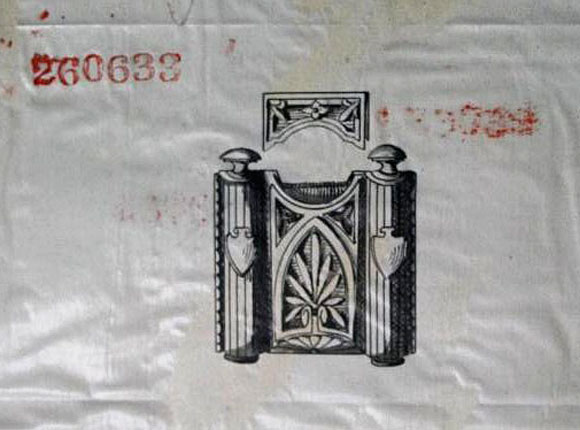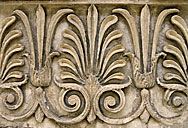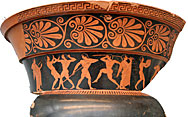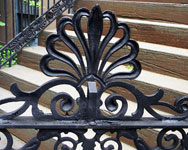Single Palmette
Name assigned based on exterior decoration
No example of this needle case has been found to date and it is unknown whether it was actually produced. If you have this needle
case in your possession or know of someone who has it, please contact us so that photographs of it can be
obtained and added to the this website.

Design Representation
Design Details
Needle Case Type: |
Flat-Names |
Patent/Registered to: |
Henry Milward & Sons - Redditch |
Patent/Design Representation #: |
Ornamental Class 1 – Metal: #260633 |
Patent/Design Registration Date: |
February 21, 1872 |
Location of Patent/Design Registration: |
The National Archives (TNA) - Kew, UK |
Reference #: |
TNA Representation - BT 43/31/260633
TNA Register - BT 44/2/260633 |
Dimensions: |
Unknown |
Material: |
Unknown |
Name Variations: |
Unknown |
Other Variations: |
Unknown |
Facts

The palmette is a decorative art motif that resembles the fan-shaped leaves of a palm tree. Each stylized palmette is composed of five to
fifteen individual leaves arranged in a symmetrical pattern with each leaf spreading out from a single base. This design is often found in
furniture, Persian rugs, and in classical moldings, reliefs, frescoes, and vase paintings.

History

Many believe the palmette originated in ancient Egypt and was based on a combination of the areas flowers, specifically the papyrus, lotus or
lily. It was a popular motif for the Ancient Greeks and Romans as well and was most often used as an architectural ornament like the one
pictured above or painted on ceramics as in the Greek vase seen below. However they called it the anthemion after a Greek flower with the same
name. During the late 18th and early 19th centuries the people of Northern Europe and the United States became increasing interested in
Classical Greek culture and as a result the Greek Revival and Neoclassical styles emerged. Many architects, artists and craftsmen included
Ancient Greek motifs in the art and architecture of the Victorian period including common household items such as jewelry, wallpaper, stained glass,
fabric, woodwork, picture frames, etc.

Miscellaneous
The Greek Revival style was especially popular in the United States because it was considered the first modern democracy and looked to ancient
Greece for inspiration as it was the birthplace of democracy. Many buildings in New York City contain Greek motifs and stylized palmette
decoration like the one on the wrought iron fence in the photograph below. The Greenwich Village Society for Historical Preservation even
adopted the palmette or anthemion as its logo when it was established in 1980.











